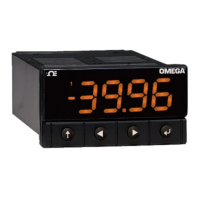PLATINUM
TM
Series User’s Guide
Reference Section: Initialization Mode (INIt)
4.6.1 No Manual Temperature Calibration Adjustment (INIt >
t.CAL > NoNE)
Select NoNE to use the standard temperature sensor calibration curves. This mode will be
used by most users.
4.6.2 Manual Temperature Calibration Offset Adjustment (INIt >
t.CAL > 1.PNt)
Select 1.PNt to manually adjust the offset of the calibration curve base on the current
reading.
Set the Manual Thermocouple Calibration Offset value in degrees.
Confirm the Offset value and pair it with the current input reading.
4.6.3 Manual Temperature Calibration Offset and Slope
Adjustment (INIt > t.CAL > 2.PNt)
Select 2.PNt to use 2 points to manually adjust both the offset and slope of the calibration
curve.
Navigate to the desired setting. Settings include the following:
• R.Lo – Set low point in degrees, default = 0, and associate with input reading
• R.HI – Set high point in degrees, default = 999.9, and associate with input reading
Select the indicated setting.
Set the Temperature for R.Lo or R.HI.
Confirm the value and pair it with the current input reading.
4.6.4 Temperature Ice Point Calibration (INIt > t.CAL > ICE.P)
Select ICE.P to calibrate the zero point for the temperature sensor. This function basically
operates the same as a 1.PNT offset adjustment restricted to a measurement at the freezing
point of water.
The LED display shows ok? and requires confirmation. Confirm the Ice Point reset.
4.7 Save Current Configuration for All Parameters to a File (INIt > SAVE)
Select Save Current Configuration Settings (SAVE) as the command to execute. If no thumb
drive is present the failure code E010 is displayed. Otherwise, a numeric designation for the
save file is then specified and confirmed before the SAVE command executes.
Important Note: The configuration file is a tab separated text file with a “.TXT” extension. It
can be loaded onto a PC, read into Excel then modified there. Once modified, save it back as
a tab separated .TXT file and it can then be loaded back into the unit using the INIt > LoAd
command. This capability can be especially useful for editing complex multi ramp and soak
programs. For more information on the configuration file format, see the “Load and Save File
Format Manual”.
Select a numeric file name from the range 0–99.
Omega Engineering | www.omega.com

